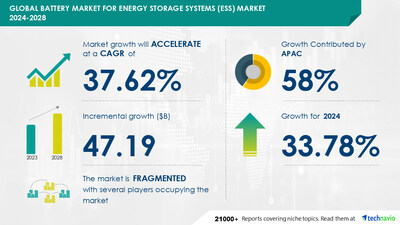NEW YORK, Nov. 20, 2024 /PRNewswire/ — Report with the AI impact on market trends – The global battery for energy storage systems (ESS) market size is estimated to grow by USD 47.19 billion from 2024-2028, according to Technavio. The market is estimated to grow at a CAGR of 37.62% during the forecast period. Changing energy mix from fossil fuels to stainable and renewable energy resources is driving market growth, with a trend towards increased adoption of microgrids. However, widening demand-supply disparity with regard to lithium poses a challenge.Key market players include ABB Ltd., AEG Power Solutions BV, Corvus Energy, dSPACE GmbH, East Penn Manufacturing Co. Inc., Exergonix Inc., General Electric Co., Hitachi Ltd., LG Electronics Inc., Mitsubishi Heavy Industries Ltd., NEC Corp., Panasonic Holdings Corp., Philadelphia Scientific LLC, Samsung SDI Co. Ltd., Siemens Energy AG, SolarEdge Technologies Inc., TDK Corp., Tesla Inc., The AES Corp., and Toshiba Corp..
Key insights into market evolution with AI-powered analysis. Explore trends, segmentation, and growth drivers- View Free Sample PDF
|
Battery For Energy Storage Systems (ESS) Market Scope |
|
|
Report Coverage |
Details |
|
Base year |
2023 |
|
Historic period |
2018 – 2022 |
|
Forecast period |
2024-2028 |
|
Growth momentum & CAGR |
Accelerate at a CAGR of 37.62% |
|
Market growth 2024-2028 |
USD 47.19 billion |
|
Market structure |
Fragmented |
|
YoY growth 2022-2023 (%) |
33.78 |
|
Regional analysis |
APAC, North America, Europe, Middle East and Africa, and South America |
|
Performing market contribution |
APAC at 58% |
|
Key countries |
US, China, Australia, UK, and Germany |
|
Key companies profiled |
ABB Ltd., AEG Power Solutions BV, Corvus Energy, dSPACE GmbH, East Penn Manufacturing Co. Inc., Exergonix Inc., General Electric Co., Hitachi Ltd., LG Electronics Inc., Mitsubishi Heavy Industries Ltd., NEC Corp., Panasonic Holdings Corp., Philadelphia Scientific LLC, Samsung SDI Co. Ltd., Siemens Energy AG, SolarEdge Technologies Inc., TDK Corp., Tesla Inc., The AES Corp., and Toshiba Corp. |
The Energy Storage Systems (ESS) market is experiencing significant growth, with lithium-ion batteries leading the trend due to their high energy density and long cycle life. Grid modernization initiatives and the increasing use of renewable energy sources are driving the demand for reliable power sources. Grid operators are turning to ESS to manage power quality and ensure grid stability. Flow batteries and lead-acid batteries are also popular choices for their cost-effectiveness and long lifespan. Manufacturers are focusing on economies of scale and manufacturing efficiency to make these technologies more affordable and accessible. Grid power outages and the need for backup power are also key factors driving the market. Utility-scale applications, such as solar and wind farms, are the largest share of the market, with above 500 MWh capacity installations becoming increasingly common. Input energy sources are primarily renewable, with raw materials like lithium, cobalt, and copper in high demand. Utilities, battery producers, and system integrators are investing heavily in this sector, with reliability and energy management systems being crucial. The market is expanding geographically, with initiatives like France Territoire Solaire and the Pillswood project leading the way. Revenue models include peak shaving, self-consumption optimization, and ancillary services like firm frequency response. ESS is being used in various sectors, from telecommunication towers and data centers to uninterruptible power supply systems and diesel generators. Lithium-ion BESS products are popular for residential installations, rooftop solar, and factories, with excess energy being stored for later use. Maintenance activities and safety measures are essential considerations, especially in harsh environmental conditions. Performance and lifespan are critical factors, with regulations and incentive programs playing a role in driving adoption. Distributed energy resources and renewable power sources are becoming increasingly important, with microgrids and self-sufficiency being key trends.
Microgrids are self-contained electricity systems that integrate local generation and energy storage resources. They can function independently or in collaboration with other small power grids, referred to as hybrid microgrids. Microgrids can switch between grid-connected and island modes, operating autonomously during power grid outages or when renewable energy sources, such as solar and wind power, are prioritized. By utilizing renewable energy sources, microgrids contribute to reducing reliance on fossil fuels, making them an essential component of sustainable energy solutions.
Request Sample of our comprehensive report now to stay ahead in the AI-driven market evolution!
• The Battery for Energy Storage Systems (ESS) market is experiencing significant growth due to grid modernization initiatives and the increasing use of renewable energy sources. Grid operators seek reliable power sources to manage the variability of renewable energy and ensure power quality. Lithium-ion batteries have the highest energy density and power conversion efficiency, making them popular for utility-scale applications above 500 MWh capacity. However, challenges such as safety measures, thermal management systems, and economies of scale persist. Flow batteries and lead-acid batteries offer alternatives with longer cycle life and lower cost. Grid power outages and the need for backup power, especially in the residential sector, drive demand for affordable and accessible energy storage solutions. Manufacturing efficiency and raw material availability, particularly for lithium, cobalt, and copper, impact battery prices. Utility-scale applications, such as solar parks and wind farms, require firm frequency response, ancillary services, and revenue models like arbitrage and capacity auctions. Harsh environmental conditions, maintenance activities, and regulations also pose challenges. Local service providers and spare parts availability are crucial for ensuring system reliability. The global BESS market includes various installations, such as BTM residential, FTM industrial, and utility-scale. Utilities, battery producers, and system integrators collaborate to optimize self-consumption, peak shaving, and backup power. Renewable energy infrastructure, electricity consumption, and disposable incomes influence market growth in the residential sector. Investments in clean-energy infrastructure, renewable energy generation, and peak power consumption drive the demand for energy storage. Lithium-ion BESS products, rooftop solar, and excess energy from factories contribute to the market. Demand charges, harsh environments, and mining operations also present opportunities for growth. Regulations and incentive programs for distributed energy resources and renewable power sources further expand the market.
• Lithium-ion batteries have emerged as the dominant technology in the energy storage systems (ESS) market, accounting for over 75% of the global electrochemical energy storage capacity in 2023. The transportation sector, specifically electric vehicles (EVs), has been a major driver of this growth. Li-ion batteries are preferred in EVs due to their advantages such as high energy and power density, safety, cost-effectiveness, and long cycle life. In addition to consumer electronics like laptops and smartphones, Li-ion batteries are increasingly being used in EVs for larger batteries and stationary storage applications. The automotive industry’s shift towards electrification is expected to further boost the demand for Li-ion batteries in the coming years.
Discover how AI is revolutionizing market trends- Get your access now!
This battery for energy storage systems (ess) market report extensively covers market segmentation by
- Connectivity
- 1.1 On-grid
- 1.2 Off-grid
- Technology
- 2.1 Lithium-ion batteries
- 2.2 Flow batteries
- 2.3 Others
- Geography
- 3.1 APAC
- 3.2 North America
- 3.3 Europe
- 3.4 Middle East and Africa
- 3.5 South America
1.1 On-grid- The on-grid battery systems market is experiencing significant growth due to the increasing adoption of renewable energy sources, particularly solar and hydropower. These systems enable storing excess energy generated during the day or peak production hours and using it during off-peak periods or when the grid is unavailable. The segment’s expansion is driven by the falling costs of solar photovoltaic (PV) systems and government support for solar installations on both utility and residential scales. Residential on-grid energy storage systems (ESS) are gaining popularity due to their benefits, such as long warranties on solar PV systems, reduced dependence on traditional electricity grids, and protection against electricity price fluctuations. Furthermore, the launch of innovative solutions, like SolarEdge Technologies’ Battery Virtual Power Plant, which allows homeowners to earn incentives by deploying their stored energy during peak demand events, is expected to fuel market growth. In addition, large-scale projects, like the 5-megawatt solar PV and 3.6-megawatt-hour battery energy storage system launched by the Asian Development Bank and the Government of Mongolia, are increasing the demand for on-grid ESS. These developments demonstrate the potential of on-grid ESS to contribute to grid stability and support renewable energy integration, making it a promising segment for growth during the forecast period.
Download a Sample of our comprehensive report today to discover how AI-driven innovations are reshaping competitive dynamics
The Battery for Energy Storage Systems (ESS) market is experiencing significant growth due to the increasing integration of renewable energy sources into the power grid. Grid modernization initiatives are driving the demand for energy storage solutions, enabling the efficient management of intermittent renewable energy generation. Lithium-ion batteries are currently leading the market, but flow batteries are also gaining popularity due to their longer cycle life and ability to use various raw materials, including cobalt, lithium, and copper. Energy demand and clean-energy investments are key factors fueling the growth of the global BESS market. The residential sector is witnessing an increase in BTM (behind-the-meter) installations for peak shaving, self-consumption optimization, and backup power. Utility-scale BESS and FTM (front-of-the-meter) installations are also crucial for grid stability, electricity consumption management, and renewable energy infrastructure development. Battery prices are decreasing, making energy storage more accessible and cost-effective for various applications.
The Battery for Energy Storage Systems (ESS) market is witnessing significant growth due to the increasing integration of renewable energy sources into the power grid. Grid modernization initiatives are driving the demand for reliable and efficient energy storage solutions, particularly lithium-ion batteries, to ensure grid stability and optimize energy conversion rates. Flow batteries and lead-acid batteries are also gaining popularity due to their unique features, such as long cycle life and ability to operate in harsh environmental conditions. Energy density, power conversion systems, control systems, and thermal management systems are crucial components of ESS, ensuring optimal performance and lifespan. Safety measures, economies of scale, and manufacturing efficiency are essential factors influencing the affordability and accessibility of these systems. Grid power operators are investing in utility-scale applications above 500 MWh capacity to address energy demand and ensure a reliable power source during peak power consumption and power outages. Renewable energy infrastructure, such as solar energy segments, is a significant input energy source for ESS, with projects like France Territoire Solaire and Pillswood leading the way. The utility sector is a major revenue model for ESS, with ancillary services, capacity auctions, and arbitrage providing significant opportunities. Telecommunication towers, data centers, uninterruptible power supply, and diesel generators are also significant applications for ESS. Battery prices, geographic footprint, and performance and lifespan are key factors influencing the global BESS market’s growth. BTM residential installations, utility-scale BESS, and FTM installations are significant market segments, with utilities, battery producers, and system integrators playing crucial roles. Reliability, energy management systems, firm frequency response, and self-consumption optimization are essential considerations for ESS, with applications ranging from solar parks and wind farms to telecommunication towers, data centers, and residential installations. Raw materials, such as lithium, cobalt, and copper, are critical components of lithium-ion batteries, influencing their cost and availability. Energy crisis, clean-energy investments, renewable-energy generation, and peak shaving are significant market drivers, with regulations and incentive programs playing a crucial role in market growth. Maintenance activities, alternative energy sources, local service providers, spare parts, and harsh environmental conditions are essential considerations for ESS, with performance and lifespan, cycle life, and energy conversion rate being key performance indicators. The market for ESS is expected to grow significantly in the coming years, driven by increasing energy demand, investments in renewable energy infrastructure, and the need for a reliable and cost-effective solution for grid power and backup power applications.
1 Executive Summary
2 Market Landscape
3 Market Sizing
4 Historic Market Size
5 Five Forces Analysis
6 Market Segmentation
- Connectivity
- On-grid
- Off-grid
- Technology
- Lithium-ion Batteries
- Flow Batteries
- Others
- Geography
- APAC
- North America
- Europe
- Middle East And Africa
- South America
7 Customer Landscape
8 Geographic Landscape
9 Drivers, Challenges, and Trends
10 Company Landscape
11 Company Analysis
12 Appendix
Technavio is a leading global technology research and advisory company. Their research and analysis focuses on emerging market trends and provides actionable insights to help businesses identify market opportunities and develop effective strategies to optimize their market positions.
With over 500 specialized analysts, Technavio’s report library consists of more than 17,000 reports and counting, covering 800 technologies, spanning across 50 countries. Their client base consists of enterprises of all sizes, including more than 100 Fortune 500 companies. This growing client base relies on Technavio’s comprehensive coverage, extensive research, and actionable market insights to identify opportunities in existing and potential markets and assess their competitive positions within changing market scenarios.
Technavio Research
Jesse Maida
Media & Marketing Executive
US: +1 844 364 1100
UK: +44 203 893 3200
Email: [email protected]
Website: www.technavio.com/
![]() View original content to download multimedia:https://www.prnewswire.com/news-releases/battery-for-energy-storage-systems-ess-market-to-grow-by-usd-47-19-billion-2024-2028-as-ai-drives-market-transformation-shift-to-renewable-energy-boosts-growth—technavio-302311066.html
View original content to download multimedia:https://www.prnewswire.com/news-releases/battery-for-energy-storage-systems-ess-market-to-grow-by-usd-47-19-billion-2024-2028-as-ai-drives-market-transformation-shift-to-renewable-energy-boosts-growth—technavio-302311066.html
SOURCE Technavio

Featured Image: Depositphotos @ lagereek











